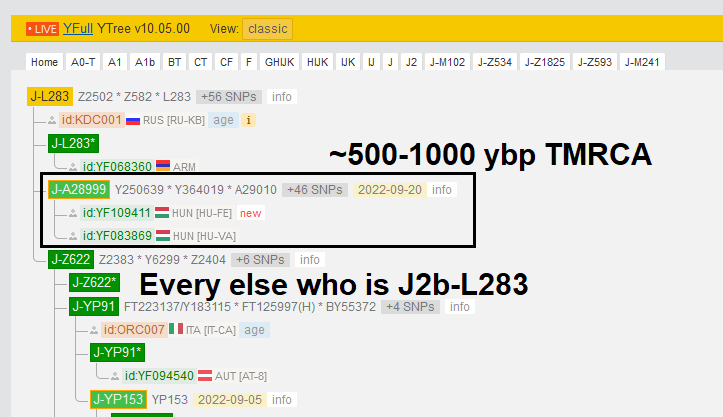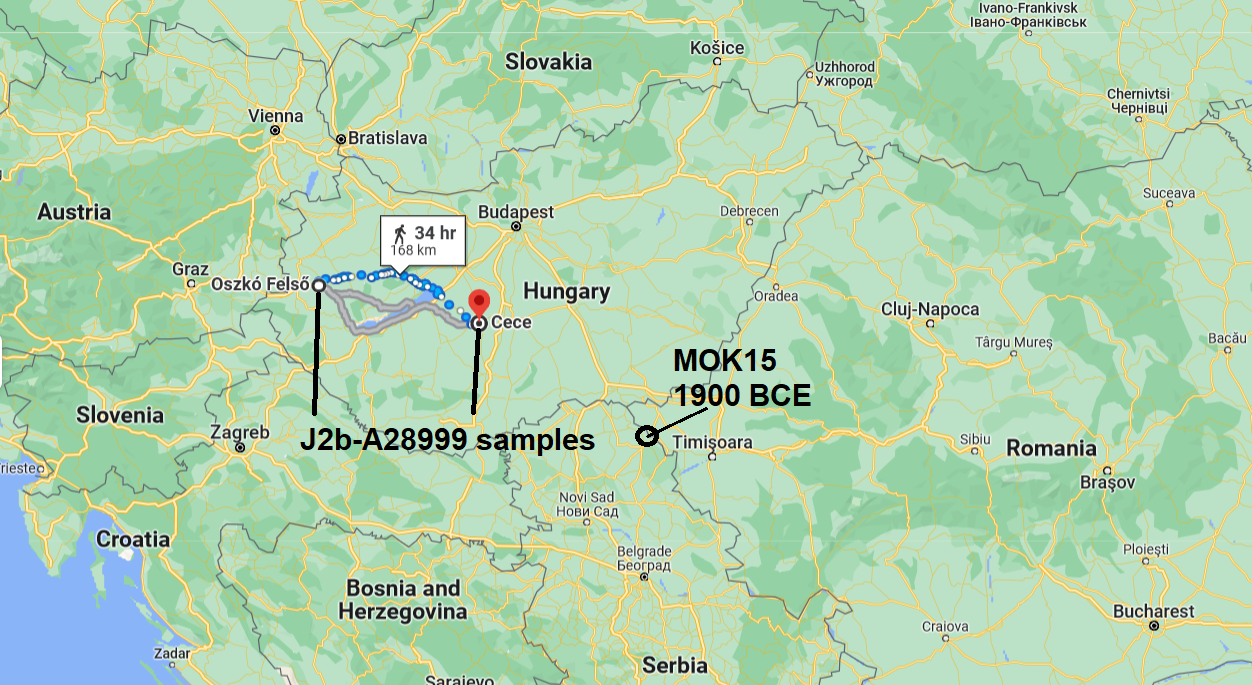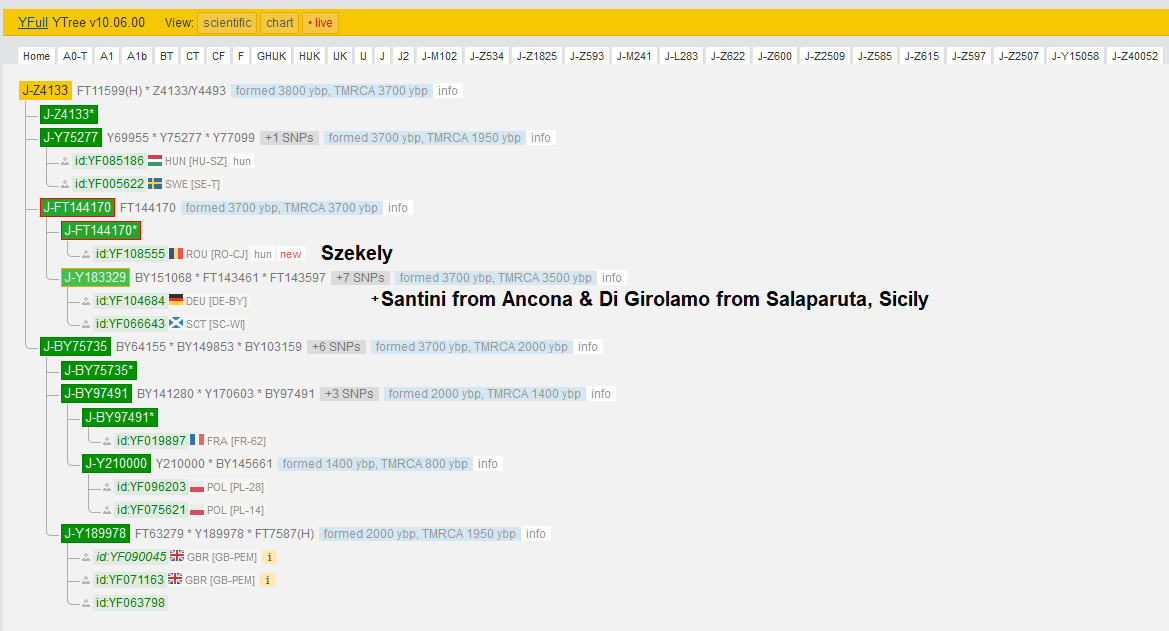Until now, there were only two modern samples positive for J2b-L283 but negative for its only known child lineage Z622.
One man traces his male line to an Armenian from Kharpert.
The other man traces his male line to Vas County, Hungary.
A few months ago, another Hungarian man who had ordered the J2b-M12 Panel at YSEQ received the same result, positive for L283 and negative for Z622. His male line goes back to the Mátéffy clan from Cece, Fejer County.
Because SNP panel results provide no indicator of how closely related a man may be to the other men at the same position on the tree relative to each other, a more advanced test was required to advance the research further. We decided to offer to help him pay for a WGS test at YSEQ.
The WGS test at YSEQ is cheaper than Big Y, covers parts of the Y chromosome that Big Y misses and are important for J2b-L283 research, provides autosomal and mtDNA results in addition, provides the BAM file at no additional cost, and is cheaper.
We have limited research funds so cost is an important factor. Also we appreciate that YSEQ supports my development of free Y-DNA research tools like Clade Finder, mt Clade Finder, Y Heatmap, Diversity Heatmap, mt Heatmap and STR Match Finder.
Discovery of J2b-A28999 as Rare Transdanubian Lineage of J2b-L283

So far this lineage has been found in three men. Two have done WGS testing and trace their male lines to opposite sides of Lake Balaton, which lies at the center of the Transdanubia region of Hungary.

These two Hungarian men are not genealogical time frame relatives of one another (in GEDmatch they do not share any segments). Their STRs and number of private SNPs probably points to a MRCA that lived within the last 1000 years or so.
I have identified a third man of unknown male parentage as a STR match to these two Hungarian men, perhaps more distantly related to them than they are to each other. Due to privacy concerns, until I am able to resume contact with the person managing his sample I cannot share more publicly, except that I consider Romania or Hungary or former Yugoslavia as the possible birth location of his biological father. I do not feel like the limited information I was provided favors one of these areas as more likely than the others.
Significance of Transdanubia for Ancient J2b-L283
I consider it significant that these two samples are found not very far from where the oldest J2b-L283 sample has been found, MOK15, from Mokrin, Serbia.
Until additional men from this lineage can be found who are more distantly related to these two Hungarian men, descending from a most recent common ancestor who lived in the Iron Age or earlier, we cannot be certain that this line has been living in or near Transdanubia since their first J2b-L283 ancestors entered the area.
Many different peoples from further north, from the east and even from Central Asia, such as Huns, Avars and Magyars, did migrate to Hungary. Roman soldiers went there as well, but the bulk of the population at that time were Romanized Pannonians - from a genetic standpoint, the hodgepodge of peoples who had migrated to or been indigenous to there going back to the first surviving Homo Sapiens migrations.
However I think it is reasonable to take as a working assumption Transdanubia or nearby as the ancient origin of this line, given the proximity to MOK15. We should also take into account that Hungary is not as heavily sampled as Serbia, Bosnia and Herzegovina, Montenegro or Albania on the YFull YTree. This line is likely not found in either Montenegro or Albania because those areas are sampled at about nine times the rate of Hungary, per capita.
I am not an expert in the demographic history of Hungary but I think Transdanubia may represent a relative refugium for J2b-L283, based on the fact that it is not part of the Great Hungarian Plain, an area which served as the base for many of the nomadic tribes from Eurasia.
Edit 10/5: I note that Cece, Fejer County, according to wikipedia maps, actually falls within both Central Transdanubia and the Great Hungarian Plain, albeit it is on the very western periphery of the plain.
Once the ancient J2b-L283 sample from Copper Age Moldova is released, we will have greater context for understanding both J2b-A28999 and J2b-Z622's likely ancient geographic origins.
Thank the Generous Donors of the J2b-L283 Research Community
Many of the samples that are advancing our understanding of the ancient origins of J2b-L283 have been upgraded to WGS thanks in part to donations from the J2b-L283 research community.
The next sample I would like to upgrade to WGS traces his line to the Santini clan of Serra de Conti, Ancona, Italy. He consents to the upgrade and will pay for a portion of the test and YFull analysis cost (total cost is $359 WGS test + $45 YFull analysis of both male and female lines).
He has been confirmed through a la carte SNP-testing at the YSEQ laboratory in Berlin to be positive for J2b-Y183329, a lineage of rare J2b-Z4133.
Due to the large number of private SNPs of the two J2b-Y183329 samples, YFull estimates their MRCA to have lived about 1300 BCE.
A man tracing his male line to Szekelys from Cluj County, Romania actually recently split this line on the YFull YTree.

By upgrading this Santini descendant to WGS we will learn whether or not he is fully J2b-Y183329 like Brownsberger from Bavaria and the sample from Scotland. There is also the chance he could be more closely related to one of these two men or he might split their lineage at a most recent common ancestor who lived in the Late Bronze Age or Early Iron Age.
To donate toward upgrading and analysis of this sample, please send to my PayPal account: